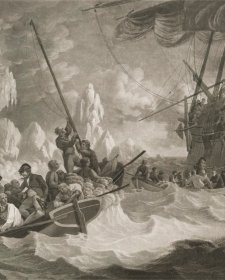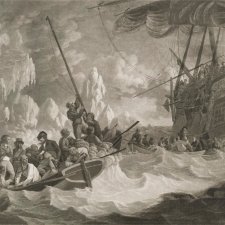The Gallery will be open until 9pm this Friday, Saturday and Sunday.
His Majesty’s ship Guardian, under the command of Lieutenant Edward Riou (1762–1801), left England in September 1789 loaded with a cargo of food, seeds, equipment and convicts intended for the settlement at Sydney Cove. The ship had an uneventful trip as far as Cape Town, where, while stopping to take on more provisions, Riou met with his former shipmate, William Bligh, who was at the Cape en route to England, having survived the Bounty mutiny and an incredible voyage to Timor in an open boat. Riou departed on the final leg of the Guardian’s journey to Sydney on 12 December 1789. About ten days later, the ship ‘fell in with several Islands of Ice, floating in the Ocean 400 leagues from land’. According to Riou’s account of what followed, he judged conditions safe enough to sail closer to the icebergs, so as to collect floating slabs of ice with which to supplement the ship’s supply of fresh water. But then the weather deteriorated and on the evening of 24 December the ship struck what Riou recalled as ‘a body of Ice full twice as high as the Masthead’. The collision opened a huge gash in the Guardian’s hull and tore off its rudder and part of the keel. The next morning, the crew attempted to remedy the damage: strapping a sail along the hull, pumping out water and jettisoning heavy objects such as guns, anchors and livestock. The following day, acknowledging that ‘little chance
was left of safety’, Riou agreed to demands from roughly half of the ship’s company to escape in the longboats. All but fifteen of those who abandoned ship perished. Riou remained on board with 60 others, including 21 convicts, who managed to keep the stricken vessel afloat for nine weeks until it drifted within sight of the Cape and was rescued. The surviving convicts and salvaged cargo eventually arrived in New South Wales in June 1790, having been distributed among the ships making up the infamous Second Fleet when they called at Cape Town. Fourteen of the convicts were immediately pardoned due to Riou’s report of their ‘admirable and wonderful’ conduct in assisting to save the Guardian.
Edward Riou began his career with the Royal Navy at the age of twelve and at fourteen, rated a midshipman, joined Captain Charles Clerke’s Discovery which, with James Cook’s Resolution, was about to embark upon Cook’s third voyage to the Pacific. Riou is believed to have received instruction in chart-making from William Bligh, the Resolution’s master, during the voyage. After Cook’s death in Hawaii in February 1779, Clerke assumed command of the expedition and transferred to the Resolution, taking Riou with him. Riou was promoted to lieutenant in October 1780 and appointed to a vessel sent to serve in the West Indies. Between 1782 and 1788, he served on British ships at home and in North America before, in April 1789, being appointed to the command of HMS Guardian. Riou returned to England following the Guardian disaster and was formally acquitted of any blame for the loss of his ship. Lionised for his bravery, he was promoted to the rank of captain and subsequently served on a series of gunships, seeing action in the West Indies and Europe during the French Revolutionary Wars. Commander of Admiral Nelson’s frigates in the Battle of Copenhagen in April 1801, Riou’s was leading the assault in his ship Amazon when one of the British ships signalled retreat. Riou reluctantly obeyed the direction (‘What will Nelson think of us?’ he is said to have asked) and was killed in the cannon fire that struck Amazonas it turned from the battery. Nelson remarked afterwards that ‘In poor, dear Riou the country has sustained an irreparable loss’, and a monument to Riou was later erected in St Paul’s Cathedral. The Battle of Copenhagen subsequently became one of the many naval battles depicted by painter and printmaker Robert Dodd.
Collection: National Portrait Gallery
Purchased 2011



On one level The Companion talks about the most famous and frontline Australians, but on another it tells us about ourselves.



Joanna Gilmour recounts the story of ill-fated sea voyages in the early stages of the Antipodean colony.



Visit us, learn with us, support us or work with us! Here’s a range of information about planning your visit, our history and more!